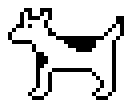
Dogcow
Encyclopedia

Bitmap
In computer graphics, a bitmap or pixmap is a type of memory organization or image file format used to store digital images. The term bitmap comes from the computer programming terminology, meaning just a map of bits, a spatially mapped array of bits. Now, along with pixmap, it commonly refers to...
ped image first introduced by Apple. It is the shape of a dog
Dog
The domestic dog is a domesticated form of the gray wolf, a member of the Canidae family of the order Carnivora. The term is used for both feral and pet varieties. The dog may have been the first animal to be domesticated, and has been the most widely kept working, hunting, and companion animal in...
, originally created in 1983 as part of the Cairo font
Typeface
In typography, a typeface is the artistic representation or interpretation of characters; it is the way the type looks. Each type is designed and there are thousands of different typefaces in existence, with new ones being developed constantly....
by Susan Kare
Susan Kare
Susan Kare is an artist and graphic designer who created many of the interface elements for the Apple Macintosh in the 1980s. She was also one of the original employees of NeXT , working as the Creative Director.-Background:Kare was born in Ithaca, New York and is the sister of aerospace engineer...
as the glyph
Glyph
A glyph is an element of writing: an individual mark on a written medium that contributes to the meaning of what is written. A glyph is made up of one or more graphemes....
for “z.” That image was later chosen for the Mac OS Print Setup dialog box, though it needed to be slightly redrawn because the original Cairo dog did not proportionally fit the Print Setup dialog box. This modified version became the image famously known as the dogcow.
The term “dogcow” was first coined by either Scott Zimmerman or Ginger Jernigan. Mark “The Red” Harlan named the dogcow “Clarus” as a joking reference to Apple’s former office-software unit, Claris
Claris
Claris was a computer software developer formed as a spin-off from Apple Computer in 1987. It was given the source code and copyrights to several programs that were owned by Apple, notably MacWrite and MacPaint, in order to separate Apple's application software activities from its hardware and...
. The sound she makes is “Moof!”
The image of the dogcow was used to show the orientation and color of the paper in Mac OS
Mac OS
Mac OS is a series of graphical user interface-based operating systems developed by Apple Inc. for their Macintosh line of computer systems. The Macintosh user experience is credited with popularizing the graphical user interface...
page setup dialog box
Dialog box
In a graphical user interface of computers, a dialog box is a type of window used to enable reciprocal communication or "dialog" between a computer and its user. It may communicate information to the user, prompt the user for a response, or both...
es. HCI engineer Annette Wagner made the decision to use the dog from the Cairo font as a starting point for the page graphic. Annette edited the original font and created a larger version with spots more suitable for demonstrating various printing options. The new dog graphic had a more bovine look, making it arguably less clear as to what animal it was intended to be, and after the print dialog was released the name “dogcow” came into use.
Excerpts from Technote 31
Apple Technote 31 includes a description of the dogcow.- There is a life-size picture of a dogcow conveniently located in the Finder. Look under “Page Setup...” Now look under “Options.” Voila, there is the dogcow in all its raging glory. Like any talented dog, it can do flips. Like any talented cow, it can do precision bitmap alignment.
- Somewhere along the line I baptized the dogcow “Clarus.” Of course she’s a female, as are all cows; males would be referred to as dogbulls, but none exist because there are already bulldogs, and God doesn’t like to have naming problems. (from History of the Dogcow, part II)

